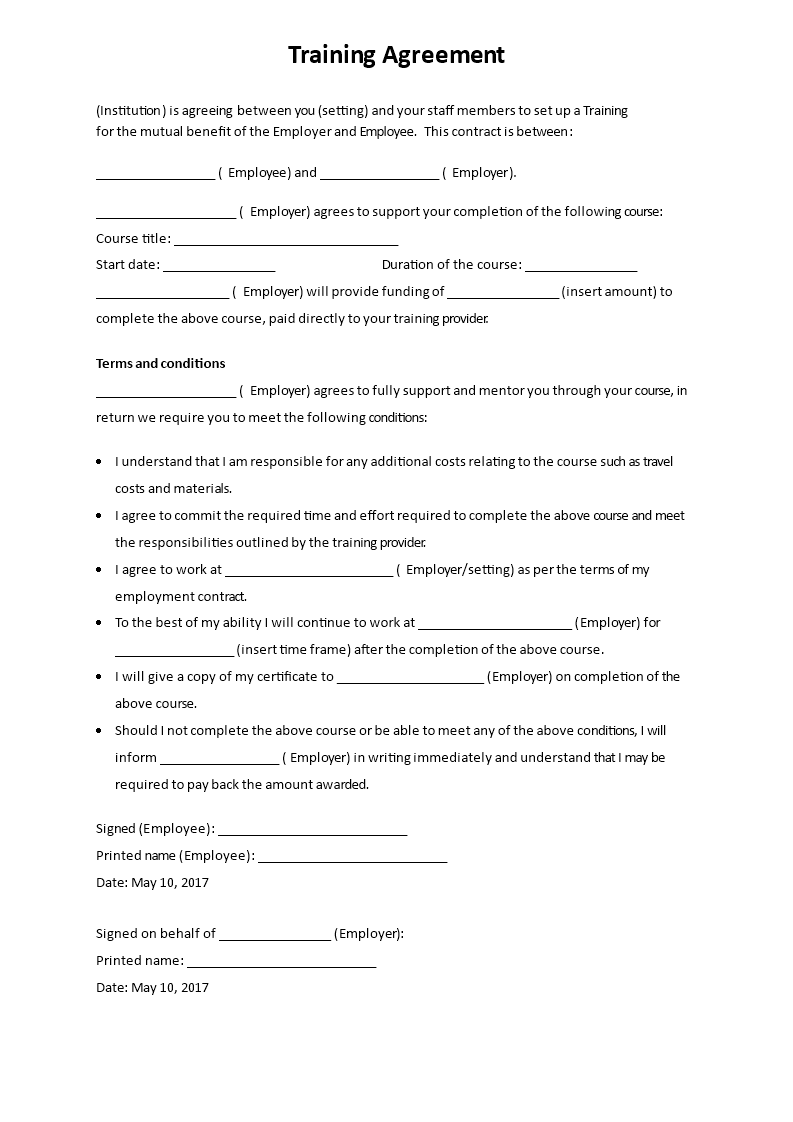
An employee training agreement is a formal document that outlines the terms and conditions of an employee’s training program. It serves as a contract between the employer and the employee, stating the responsibilities and expectations of both parties during the training period. The agreement is typically signed before the commencement of the training and ensures that all parties are aware of their obligations and rights.
Why Do Companies Need an Employee Training Agreement?
Companies need an employee training agreement to establish clear guidelines and expectations for employee training programs. By having a written agreement, both the employer and the employee have a reference document that can be used to resolve any disputes or misunderstandings that may arise during the training period. It also helps to protect the company’s investment in training by ensuring that employees complete the required training and adhere to any post-training obligations.
Furthermore, an employee training agreement demonstrates the company’s commitment to employee development and professional growth. It shows that the company values its employees and is willing to invest time and resources in their training and development. This can lead to increased employee satisfaction, loyalty, and productivity.
What Should an Employee Training Agreement Include?
an employee training agreement should include the following key elements:
1. Training Objectives: Clearly state the goals and objectives of the training program.
2. Training Schedule: Provide details about the duration, timing, and location of the training sessions.
3. Training Content: Outline the topics and skills that will be covered during the training.
4. Training Methods: Describe the training methods and techniques that will be used, such as presentations, workshops, or hands-on exercises.
5. Trainer Qualifications: Specify the qualifications and experience required of the trainers who will be conducting the training.
6. Obligations of the Employee: Clearly state the employee’s responsibilities and obligations during the training period.
7. Obligations of the Employer: Outline the employer’s responsibilities, such as providing necessary resources and support for the training.
8. Confidentiality and Non-Disclosure: Include a clause that addresses the confidentiality of training materials and any proprietary information that may be shared during the training.
9. Termination Clause: Specify the conditions under which either party can terminate the training agreement.
10. Signatures: Provide spaces for both the employer and the employee to sign and date the agreement.




How to Create an Employee Training Agreement
Creating an employee training agreement involves the following steps:
- Gather Information: Collect all the necessary details about the training program, including the objectives, schedule, content, and trainer qualifications.
- Write the Agreement: Use a formal and concise writing style to draft the agreement, ensuring that all the key elements mentioned earlier are included.
- Review and Edit: Carefully review the agreement for any errors, inconsistencies, or missing information. Make any necessary edits or revisions.
- Seek Legal Advice: If needed, consult with an employment law attorney to ensure that the agreement complies with all applicable laws and regulations.
- Finalize and Print: Once the agreement is complete and reviewed, print it on company letterhead or use a professional template for a more polished look.
- Sign and Distribute: Have both the employer and the employee sign and date the agreement. Provide copies to all relevant parties, including the employee, HR department, and any trainers involved.
Benefits of Using an Employee Training Agreement
Using an employee training agreement offers several benefits for both employers and employees:
1. Clarity and Transparency: The agreement provides clear guidelines and expectations for both parties, ensuring that there is no ambiguity or confusion.
2. Legal Protection: The agreement serves as a legal document that can be used to resolve any disputes or conflicts that may arise during or after the training period.
3. Accountability: By signing the agreement, employees are held accountable for completing the training and adhering to any post-training obligations.
4. Professional Development: The agreement demonstrates the company’s commitment to employee development and encourages employees to take ownership of their professional growth.
5. Employee Satisfaction: Providing a structured training program with a formal agreement can enhance employee satisfaction and loyalty.
Final Words
An employee training agreement is a valuable tool for both employers and employees. It establishes clear guidelines and expectations for training programs, protects the company’s investment in employee development, and promotes a positive and productive work environment. By using an employee training agreement, companies can ensure that their employees receive the necessary training to excel in their roles and contribute to the overall success of the organization.
Employee Training Agreement Template Word – Download